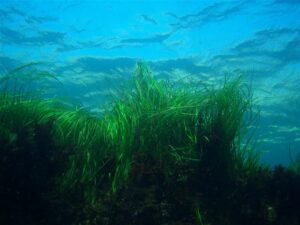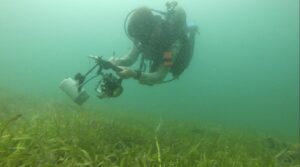by Isabella Eclipse
Video created by United Nations Environment Programme
Appearances can be deceiving. At first glance, the humble seagrass meadow resembles a weedy underwater lawn. A closer look reveals one of the most important—and threatened—marine ecosystems in the world. Unfortunately, conservation efforts have often overlooked seagrass habitats.
“For a long time, people saw seagrass as a nuisance,” explained Jonathan Lefcheck, a biologist with the Smithsonian Environmental Research Center. It had a reputation for clogging boat propellers and washing up on beaches. “Tropical resorts would hire people to dig up seagrass in front of their beach because people would complain,” he added.
Though public perceptions have been changing, many people today are still unaware that seagrass meadows are rich and vibrant ecosystems like coral reefs or rainforests. A new report from the United Nations Environment Programme hopes to change that. Released June 8 on World Oceans Day, Out of the Blue compiles the latest findings from around the world on seagrasses and the valuable services they provide. SERC biologist Emmett Duffy served on the steering committee and helped synthesize the report.

Seagrasses growing in the Channel Islands off the coast of Southern California (Credit: Claire Fackler/NOAA)
Seagrass meadows act as the “lungs” of the ocean, producing oxygen through photosynthesis like rainforests on land. They also serve as a crucial link between other ecosystems. At the border of land and sea, seagrasses protect the coast from storms and help prevent erosion. They even fight climate change, sequestering up to 18% of the ocean’s carbon.
If that weren’t enough, seagrasses are also biodiversity powerhouses, sheltering endangered species like manatees, sea turtles and sea otters. They also ensure the survival of baby fish, who spend their first days sheltered in the safety of seagrass “nurseries” before venturing out into coral reefs or mangrove forests. The health of seagrass is, therefore, vital to the seafood industry. In fact, scientists estimate that seagrass supports 20 percent of the world’s largest fisheries.
Seagrass meadows are one of the most abundant marine ecosystems in the world. With 72 species of seagrass spread over 159 countries and six continents, chances are there is a seagrass meadow near you! One study found that over 1 billion people lived within 100 km (62 miles) of a seagrass meadow.
Despite their global importance, however, only 26 percent of seagrass meadows are preserved within a “marine protected area.” This is especially alarming as seagrass habitat is declining at a rate of 7 percent a year. Today threats like nutrient pollution, destructive fishing and boating practices, coastal development, and climate change all put seagrasses at risk.
Duffy believes that seagrass ecosystems around the world can recover, despite existing challenges, if given the chance.
“When measures have been taken to improve water quality, there have been dramatic increases in seagrass coverage,” Duffy said.
A 2018 study led by Jonathan Lefcheck found that the regulation of nutrient pollution beginning in 1984 allowed seagrass beds in the Chesapeake Bay to quadruple in size. That study, involving 14 scientists and managers, proves that environmental regulation can be very effective in seagrass restoration. But individual actions are still essential to supporting healthy coastal ecosystems.
Here are a few actions you can take to protect seagrasses:

A biologist surveys fish on a seagrass transect. (Credit: Emmett Duffy, Smithsonian Tennenbaum Marine Observatories Network)
- Don’t fertilize your lawn. Rain washes fertilizer into waterways, bringing excess nutrients which cloud the water and cause harmful algae blooms that can stifle seagrass growth.
- Place a low barrier around any active construction sites, to keep loose dirt from washing away. This is often required by law, so if you see that proper protocol is not being observed, you can call your local building inspector.
- Practice caution when enjoying water sports and leave a light footprint on the environment. Aerial imaging has revealed that boats leave huge scars in seagrass beds when their anchors drag along the seafloor.
Clearly, the protection of seagrasses is vital for the well-being of our oceans. But Duffy also emphasized that the health of seagrasses, coastal communities and people are inseparable.
“The old expression is that no man is an island, but no habitat or species is an island, either,” he said. “This is really the primary lesson of ecology: everything depends on everything else.”
Read the full United Nations Out of the Blue report
Learn more:
Chesapeake Bay’s Underwater Plants Stage Record-Breaking Comeback, Thanks to Nutrient Diet
Eelgrass Wasting Disease Has New Enemies: Drones and Artificial Intelligence
What’s Hurting the Chesapeake’s Underwater Plants?
The Blue Carbon Market is Open

